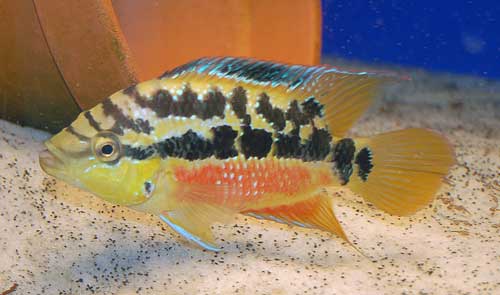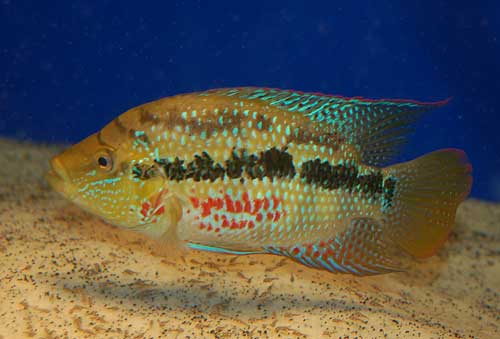'Cichlasoma' salvini
(Günther, 1862)
Salvini, Tricolor Cichlid, Mini Guapote
Synonyms: Nandopsis salvini, Parapetenia salvini

Above: A female Salvini. Photo by Rick Borstein.
Etymology:
Genus-Kichle= wrasse like (Greek), soma= body (Greek).
Species-salvini= Named after O. Salvin.
Intro:
'Cichlasoma' salvini is a beautiful, medium sized Central American cichlid. Although not large compared to some of the Central American guapotes, "Cichlasoma" salvini packs the same amount of punch. These little guys are tenacious. This fish, first typed by Gunther in 1862 with a locality at Lago Peten, is a very popular Central American in the aquarium hobby.
This fish is a nomad when it comes to nomenclature and has never really been put in the proper genus. It is quite likely this fish will be put in a brand new genus. It's also possible that some of the location variants of the Tricolor Cichlid may be described as valid species as it is quite a variable fish throughout its range.
Distribution:
This fish is found in Belize, Guatemala, and Mexico. The Tricolor Cichlid is found in rivers as well as ponds and lakes. Some populations even inhabit sulfurous habitats.
Size, Maturity, and Sexual Dimorphism:
Size: Males- 7 inches, Females- 6 inches
Maturity: 3.5 inches
Sexual Dimorphism: Males are a little bit larger than females. Although both are colorful, females have much more of an intense color compared to the males. Females also possess a dorsal blotch. Males do obtain longer fin extensions.

Above: A male Salvini. Note the color difference. Photo by Rick Borstein.
Care:
This fish is super aggressive, so give them a big tank. I was able to get away with a pair in a 5 foot 75 that was divided with some Port Cichlids on the other side, but I wouldn't recommend it. Big tanks and lots of filtration is needed to keep this fish in prime condition. This fish does mix well with other large Central American species if one was making a large display tank; emphasis on large tank.
Diet:
Feeding Tricolor Cichlids is easy. They are omnivorous in the wild, but will gladly eat anything in the aquarium. I fed mine Spectrum, Dainichi, and Tetra Cichlid Sticks. These kept the fish in great condition.
Breeding:
I found breeding Salvini to be somewhat difficult. My female was always in spawning condition, but my male always tore her to shreds. After one bad beating, I decided to give the male the penalty box treatment, a little floating 6 inch by 6 inch box. He stayed there for a month. I then released him back into the 75 and then they spawned.
Slavini lay about 250-1000 eggs. They hatch in about three days and four days after that are free swimming. The fry are protected well by their parents. They grow fast and by the end of a month are about 1 inch.
Conclusion:
This is not a beginner Central American although many pet shops would tell you otherwise. It is a very pretty and aggressive fish. I recommend it to any Central American and South American cichlid breeders. This fish is popular and is usually seen in pet shops as well as fish clubs.
References:
- Günther, A. (1862) Catalogue of the Fishes in the British Museum. Vol. IV. British Museum, London, 534 pp.
- Miller, R.R., Minckley, W.L. & Norris, S.M. (2005) Freshwater Fishes of México. Museum of Zoology, University of Michigan, & University of Chicago Press, Chicago, 652 pp.
